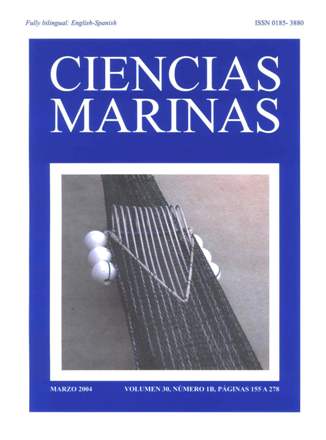Intensive culture of Litopenaeus vannamei Boone 1931, in a recirculating seawater system
Main Article Content
Abstract
The intensive culture of Litopenaeus vannamei continues to expand and their study in recirculating rearing tanks with limited water volume is scarce. The aim of this research was to cultivate white shrimp postlarvae (PL 13) for five months in a 5.85-m3 rearing unit. Vertical mosquito screen curtains augmented the tank area of the rearing unit from 13.9 (wall surface) to 84.6 m2. The total water volume (11 m3) was recirculated at a rate of 7.2 m3 h–1. Shrimp postlarvae were fed with fine-graded Camaronina mixed with water for one month and then replaced with Camaronina pellets distributed automatically twice a day. During the trial, water temperature ranged from 23.0ºC to 25.8ºC, oxygen from 5.3 to 7.5 mg L–1, and salinity from 27.5‰ to 28.4‰. At the end of the experiment, water quality was pH 7.4, NH3-N = 0.8 mg L–1, NO2-N = 0.287 mg L–1, PO4 = 7.9 mg L–1, and total PO4 = 1.71 mg L–1. The final crop for the unit was 56.7 kg, with a shrimp mean mass of 4.001 g, and a maximum and minimum of 8.484 and 0.384 g, respectively. In terms of the total recirculated seawater volume (11 m3), the production was 5.15 kg m–3, and in relation to the tank volume, 9.7 kg m–3; considering the tank surface without curtains, production was 4.1 kg m–2, and with curtains, 0.67 kg m–2. The design and installation of the curtains is a viable tank modification to increase the available space in a reduced water volume. Our results indicate that the mean residence time (1.23 h) of the water recirculation in the rearing unit can sustain high water quality. Another extension of our results is to make use of the design to culture postlarvae as a nursery unit to raise juveniles less than 4 g for subsequent transfer to culture facilities. However, it is much more important to implicate in the analysis the use of land that in some countries, such as Mexico, constitutes vast regions of useful agricultural land, transformed into culture ponds to increase the national shrimp production. In this sense, shrimp production of the experiment in terms of the base area (7 m2) of the culture tank was 8.1 kg m–2.
Downloads
Article Details
This is an open access article distributed under a Creative Commons Attribution 4.0 License, which allows you to share and adapt the work, as long as you give appropriate credit to the original author(s) and the source, provide a link to the Creative Commons license, and indicate if changes were made. Figures, tables and other elements in the article are included in the article’s CC BY 4.0 license, unless otherwise indicated. The journal title is protected by copyrights and not subject to this license. Full license deed can be viewed here.

